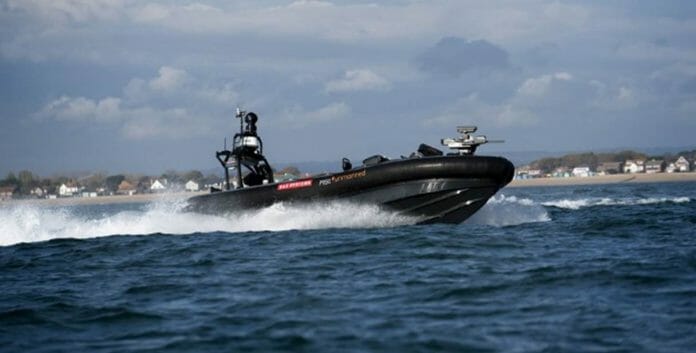Recently, BAE Systems has successfully completed a series of pilot runs on its ‘first of its kind’ autonomous boat which allows navies to go beyond the limits of human endurance with unmanned vessels. These vessels can travel further, for longer and to more inhospitable environments.
The autonomous Pacific 950 Rigid Inflatable Boat (RIB) demonstrator has been used to develop and prove innovative technologies which have the potential to make naval missions faster, easier and safer, taking the relationship between human and machine to new territories.
Developed alongside industry experts from L3Harris and MSI Defence Systems, the P950 is equipped with automated navigational decision-making technologies, freeing up operators to focus on mission critical information from afar.
The vessel can operate for up to 10 days at ‘patrol speed’ or 300 nautical miles in pursuit mode, reaching speeds of up to 45 knots, whilst either being remote controlled or on a semi-autonomous mission. Trials conducted by BAE Systems have shown how the technology provides a unique ability to undertake complex, multi-phase missions and support advanced dynamic tasking, whilst providing enhanced situational awareness to support faster and more effective decision-making by naval operators.
It has potential applications across a range of missions, including anti-piracy operations, border control, persistent intelligence gathering, maritime security and force protection. The use of autonomous vessels in high-risk areas would allow operations to be conducted without endangering sailors.
Mike Woods, Chief Technologist for BAE Systems’ Maritime Services business, said “This technology represents a huge step forward in the interaction between human and machine, combining sophisticated autonomous technology with human capabilities to overcome many of the challenges faced in difficult conditions at sea. The boat keeps sailors out of harm’s way whilst allowing them to respond to the increasingly varied, often unpredictable scenarios they face every day, and aids faster decision making in complex and ambiguous situations.”
Precision delivery
The boat has pre-programmed intelligent behaviours to position itself appropriately in relation to a potential threat. Its weapons system, developed by MSI Defence Systems with BAE Systems, remains firmly under a human operator’s control, ensuring that whilst the vessel can operate and navigate autonomously, there will always be a highly-trained operator in the loop, making the final decision on engagement and targeting.
Proving the technology
First introduced on an experimental basis in 2015 and tested as part of the Royal Navy’s Unmanned Warrior exercise in 2016, the work now completed, in collaboration with the UK Ministry of Defence, has evolved the technology on the P950 demonstrator to an advanced state of readiness.
Mr Woods added, “For the past four years we have been working in collaboration to develop this ‘first of its kind’ technology. We are proud to have matured autonomous maritime technology significantly, positioning the UK as a forward thinker in this unique space and providing a crucial advantage where it counts.”









